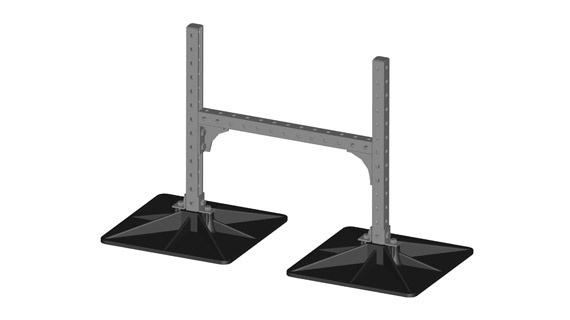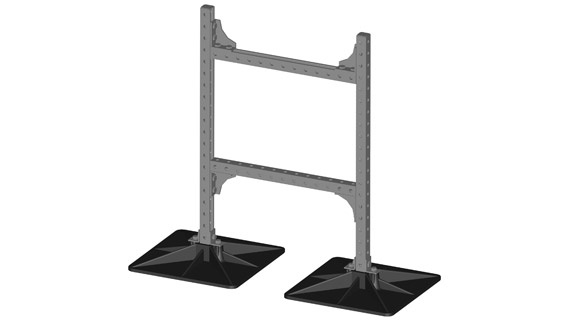Delivering just the right temperature and air quality to every square inch of a commercial building involves a complex, sprawling configuration of ductwork, cabling, and pipes. To ensure the security and safety of this equipment, save space, and reduce noise pollution, many building owners choose to house their HVAC systems on their rooftops. However, these advantages can quickly turn into liabilities if the rooftop environment isn’t properly outfitted to support such large, heavy equipment. Most commercial roofs don’t last as long as their projected lifespan. Some can deteriorate in as little as 20 to 30 years! More often than not, premature deterioration is the result of infrastructure issues that could have been avoided, such as:
Poorly-designed equipment and ducting supports don’t just put the lifespan of your roof at risk; they also jeopardize the safety of expensive building equipment and the maintenance professionals who tend to these systems.
The PHP-D duct support leverages a goal-post design with a single crossbar below the duct to support all sizes of square or round ducting, cable trays, and piping. This support can meet nearly all height requirements above the roof surface and is approved for seismic and high-wind applications.

The PHP-D enclosed duct support leverages an enclosed design with a crossbar below and above the duct to support all sizes of square or round ducting. This system can also support cable trays and piping and comes with an uplift bar for seismic and high-wind applications.


PHP Systems/Design zero-penetration ducting supports preserve the integrity of your roof without violating rooftop warranties for a safer, more efficient rooftop environment that drastically reduces liabilities. Additionally, every system comes with a 5-year warranty. Should any component of your ducting supports require attention, we will provide a replacement to protect the value and sustainability of your system.
The best way to maximize safety and the lifespan of your commercial investments is with a customized support system designed around the exact specifications of your rooftop environment.
Designing an efficient, sustainable support system for ductwork is only the beginning. Equally important is the architect's ability to communicate that design to the installation crew. As you vet professionals, add the following three qualities to your list of qualifications:
All designs begin with a thorough assessment of your rooftop environment. The following specifications are crucial to the quality and success of the design:
Flat and sloped roofs can be retrofitted with ducting supports; however, the calculations used to factor weight distribution, wind resistance, and other performance requirements will vary depending on the degree of the slope.
Your roof’s load capacity will determine how much equipment your roof can safely hold and how equipment should be spaced to distribute weight properly. In addition to the dead load, your designer must factor in potential live loads, such as maintenance professionals who will occupy the space.
The shape, height, and width of your ducting will depend on airflow rate, the total effective length of the duct system, the friction rate, and other essential details. Ducting supports should be designed around these specifications to hamper noise, prevent erosion, protect ductwork from environmental risks, and evenly distribute weight.
Design details must support the environment you have today as well as potential changes to that environment in the future––for example, expanding the building or turning the roof into a green space or parking lot.
Ducting supports must account for any movement that takes place due to changes in temperature, load, vibration, and other elements. Because movement can be unpredictable, your designer should account for motion in all directions.
In addition to standard weatherproofing, material selection should factor in constant UV exposure and extreme conditions, such as hurricane-force winds, tornadoes, and earthquakes. Some regions are more prone to these conditions than others and will have stricter building codes.
The designer should be keenly aware of the consequences of fastening support bases to the physical roof structure, including how penetration might impact warranties and how adhesives will react to the roof’s surface material.
Design layouts should consider human traffic and allow maintenance professionals to safely and effortlessly navigate the rooftop environment for inspections, repairs, and other routine activities.
The affordability of your rooftop support system shouldn’t be decided at face value. Instead, think about how that cost will amortize over the years. In other words, low-cost solutions may seem like an attractive option upfront, but sustainability is the real value point. You might find yourself repairing or replacing a low-cost system before you see ROI.
PHP Systems/Design is the leading designer, manufacturer, and supplier of the first-ever zero-penetration rooftop support systems. Our zero-penetration method solves every rooftop challenge by managing the dead weight, live load, and displacement of HVAC units, ducting, piping, and cable trays without affecting the roof’s protective membrane.
Every zero-penetration system is customized according to the exact specifications of your rooftop. Our designers use advanced software to illustrate designs in detail and (if necessary) will submit designs for a PE stamp to ensure compliance with all state and local building codes. We work with architects, property owners, and facility leaders across numerous industries, including:
According to the Bureau of Labor Statistics, falling onto or off of a roof is the number one cause of death for rooftop workers and the second most fatal occupational hazard. One hundred percent of these accidents are preventable. The Occupational Safety and Health Administration (OSHA) is cracking down on rooftop safety standards to improve these grave statistics, including proper roof platform systems to stabilize work environments.
If your ductwork is supported with wooden blocks, untreated metal, plastic, or rubber materials that corrode, crack, deteriorate, and weaken over time, equipment can shift or crash onto the roof’s surface. These issues can also lead to drainage problems or leaking that damages the interior components of your building or develop into soft spots on the roof’s surface––all of which can result in a fatal accident. If a complaint or accident occurs and OSHA gets involved, a government inspection is imminent and will likely result in citations and costly penalties.
Our ducting supports are constructed with hot-dipped, galvanized carbon steel framing and high-density/high-impact polypropylene, UV-protected bases that won’t crack, corrode, or weaken over time––even in the most extreme environmental conditions. Due to their high-quality construction, our ducting supports will:

PHP Systems/Design
5534 Harvey Wilson Dr.
Houston, TX 77020
Copyright PHP Systems/Design. All rights reserved.